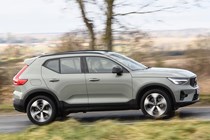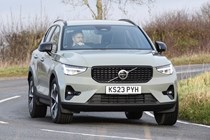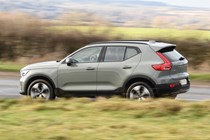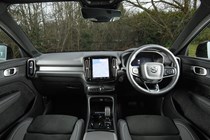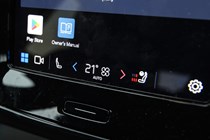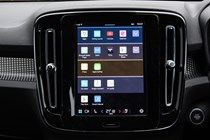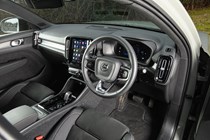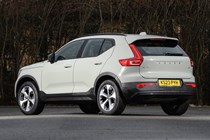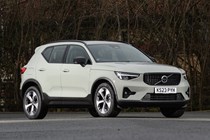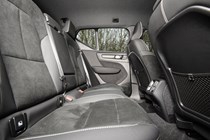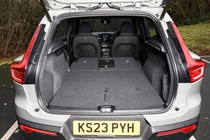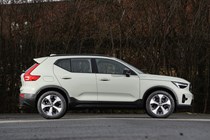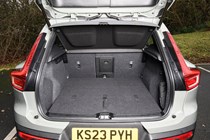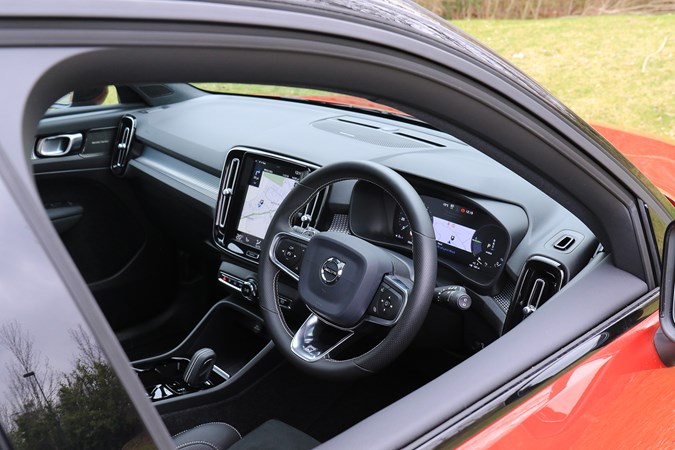
Volvo XC40 long-term test
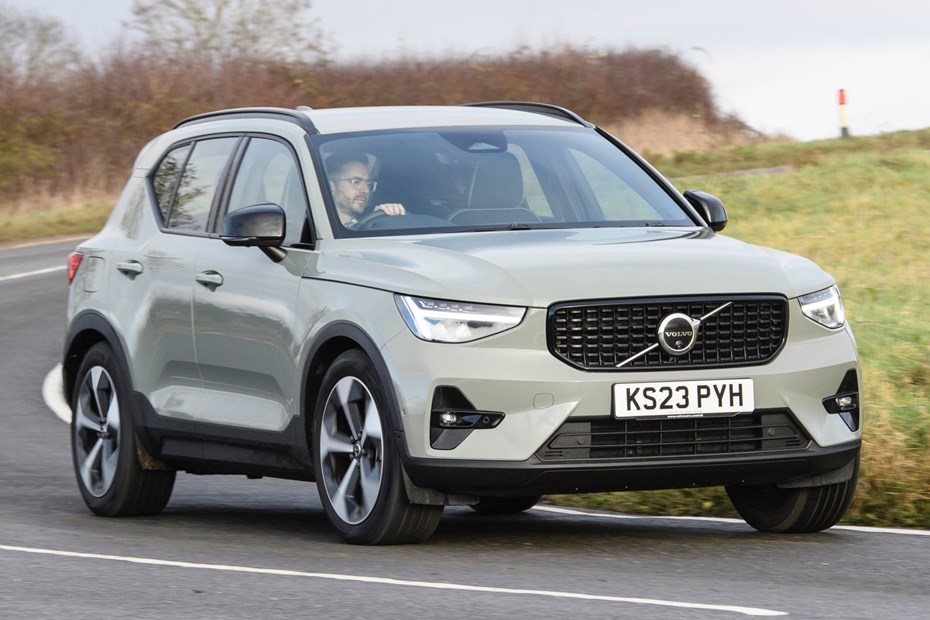
Update 1: Welcome
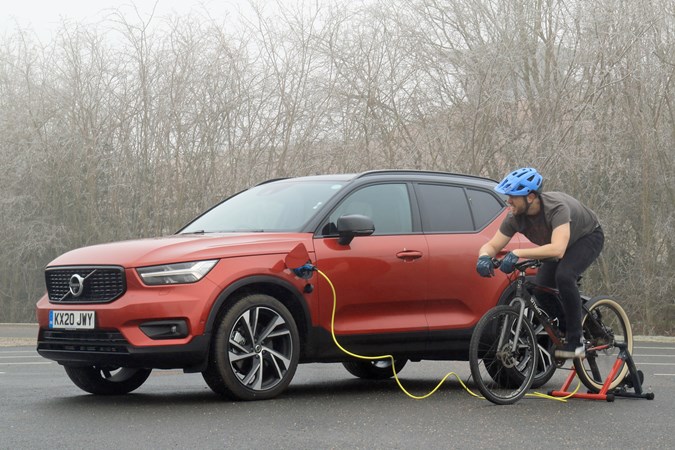
Plug-in hybrids will no longer be sold after 2035, shortly after regular petrol and diesel cars go off sale. Is this XC40 a good stepping stone on the way to an EV, or should you go straight for pure battery power?
Times have changed a lot since the last time I ran a plug-in hybrid long termer. That car (a VW Golf GTE) had to put up with a lot of long motorway drives for photoshoots, launches (or more likely) bike trips plus a commute which, at the time, was just too long. So while it was capable of using very little fuel, I didn’t often give it a chance to demonstrate it.
To balance things out I leant the Golf to one of my Bauer colleagues whose commute fit the 20-odd miles the battery could provide, and he loved it. In fact he bought one. However, if your lifestyle is as erratic as mine (used to be) then more often than not you’ll end up with a thirsty petrol engine lugging a flat battery around. So while I loved the styling and the breadth of ability with that car, it really was a case of ‘it’s not you, it’s me’ with the fuel economy.
Times have changed though and for a lot of us the journeys we make in our cars have changed with them. Fewer photoshoots and car launches, and crucially no commute or early morning airport runs, means in my first month this plug-in Volvo XC40 T5 Recharge has gone through less than half a tank of petrol. Even my frequency of bike rides had dropped off, except for those in my garage strapped to a turbo trainer. If only there was some way of charging the battery with pedal power.

I’m sure things will change a little bit now Lockdown 2.0 is behind us – but my journeys so far have included running the kids about in the morning, going to the shops and the odd family excursion on the weekend for exercise. Rarely have these trips breached the Volvo’s claimed 28 mile battery range. Now though with an increase in work events perhaps that fuel economy will suffer.
One thing’s for certain – a car’s driving experience improves dramatically when you’re able to plug it into the wall, especially in winter. From my warm bed I can tell the Volvo to defrost itself and activate my heated seat and steering wheel so they’re toasty when I get in, all while my neighbours are still outside scraping.
That’s not all. Electric propulsion is just a nicer way to move around town. It’s unobtrusive, smooth and picks up instantly, so there’s no faffing around at roundabouts or when red lights turn to green like some of my previous cars (ahem, Audi A6 Allroad). It’s also feels great to take the family out for some fresh air, and not immediately fill said air with exhaust fumes.
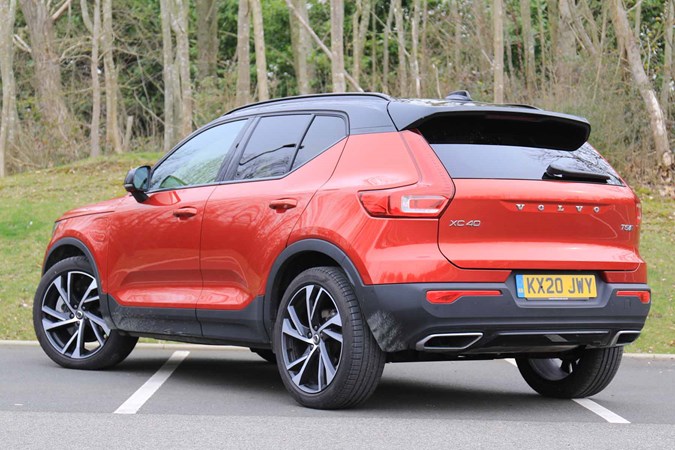
It’s a super chilled experience on faster roads too, the petrol engine occasionally chiming in to boost acceleration and then subduing itself again when you’re up to speed, making for a very quiet and relaxing cabin. In fact the best way to drive this XC40 is to work as hard as possible to keep the petrol engine out of the picture.
So, is the plug-in hybrid drivetrain in the XC40 still incompatible with my lifestyle? Would a standard petrol or pure electric make more sense? And just what is my tow bar bike rack going to do to the fuel economy? In six month’s time we’ll have answers to all those questions and more.
Update 2: Interior and comfort
The XC40’s interior needs to be good value for money at one end of the brochure and capable of competing with other £50,000 SUVs at the other. Is that too much to expect one car to do, or can this Volvo offer all things to all people?
The idea of doing longer journeys in the XC40 has been somewhat torpedoed by another covid lockdown. I’ve been driving reasonably regularly, but none of my journeys have needed any combustible fuel to be used.
At first this filled me with an immense feeling of wellbeing as I wafted around in battery powered refinement without producing any tailpipe CO2, until I realised I’ve been hauling a heavy, unused petrol engine the whole time. That’s a role-reversal from my last plug-in hybrid long termer, except in that instance it was the electric motor and battery that often fell redundant.
Still, those shorter journeys have given me plenty of time to poke and prod at the Volvo’s interior and try and separate it a bit from the V60 long termer I previously ran and Keith’s old S90, which I drove a few times when I could convince him to give me the keys.

Why are those cars relevant? Well, better than anyone else (I think) Volvo offers a very level field of interior quality across its range of cars. This XC40 is the Swedish maker’s smallest car and yet it doesn’t feel like a nose-dive inside compared to more expensive models. Sure, it doesn’t have the massive crystal gearshifter from Murray’s XC90, but if anything that’s a bonus.
Partly this is because all Volvos share the same 9.0-inch portrait touchscreen and 12.3-inch driver’s display, so there’s no disparity in screen tech, although the Sensus system is starting to look a bit dated compared with the crisp graphics and IMAX-worthy set up in an Audi, for example.
The sat nav graphics are a bit cartoony and while you can show an overview of your journey on the main screen and turn-by-turn on the driver’s screen, you have to keep manually moving and zooming-in on the map. I like having a picture of the whole trip on the big display, if only to neutralise “how much further?” inquiries from younger passengers, and most other two-screen setups can cope with this.
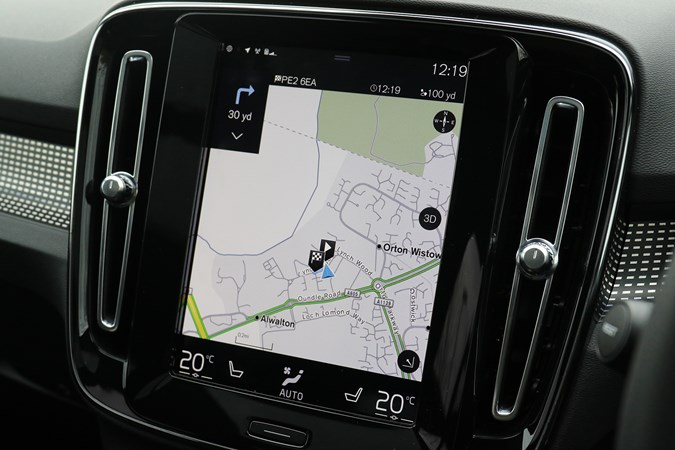
I still like the portrait orientation though, and it’s just as useful in this more modest size as the gargantuan units in a Ford Mustang Mach-E or Tesla Model X, because it shows more of the road in front of you on the map.
The most popular car functions are also all contained within a page located one swipe to the right so there’s no hunting around in a dozen menus to put the traction control in sport mode, for example (hello VW Golf, I’m talking about you again).
It’s also worth bearing in mind that cars like the XC40 (in fact, particularly the XC40) are now offered with a massive range of engines, from cheap petrols to expensive PHEVs and fully electric too. As such this T5 R-Design Pro with its extra motor and batteries costs nearly double the price of the entry-level petrol car. We’ll talk about whether this drivetrain is worth it in a later update – for now though consider the challenge in making a car interior that returns a profit at £25,000, while being high enough quality to compete with £50,000 rivals.
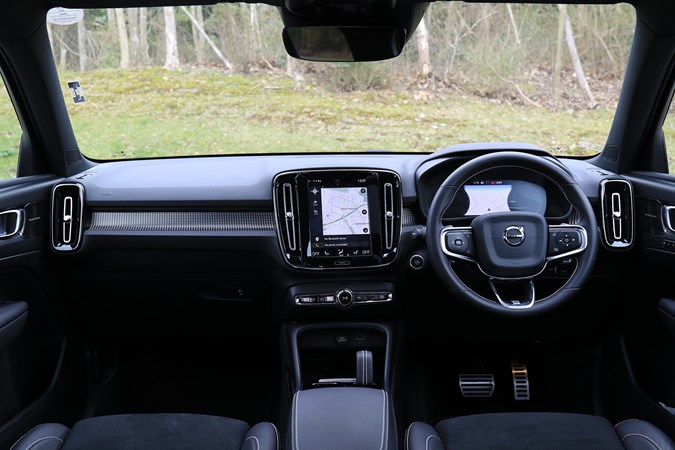
For the most part the XC40 succeeds. Everything feels substantial and hefty, from the metal door handles to the soft leather and suede used on the wheel and seats. This is a well-specified R-Design Pro car but there are few throwbacks to cheaper model it’s based on.
That said, there are two slightly flimsy plastic sections under the main screen and above the buttons in the centre console, and in my car this interface has developed a small squeak when it’s cold. This is pretty annoying.
The centre console buttons themselves (what few there are) feel nice though and have a glassy effect – in my V60 long termer this was carried over onto the steering wheel controls too, although in the XC40 these have a matte plastic finish. This is genuinely the only place where this car feels cheaper than the larger one.
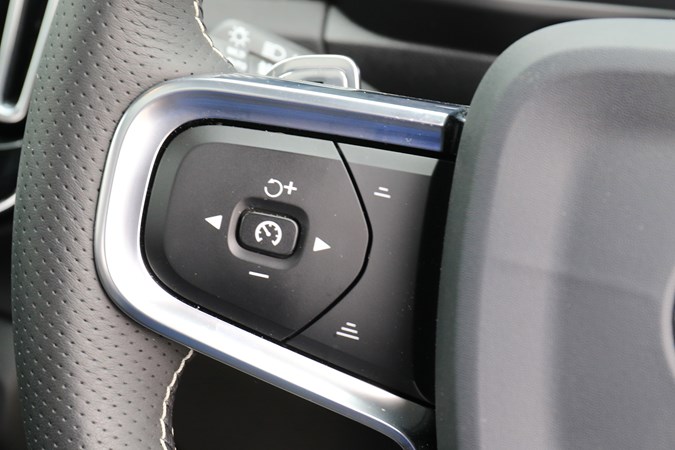
It’s got a different driving position, as you’d imagine, with more of an upright feel than the low-slung V60’s, but both cars have really excellent seats. There’s a memory function on the driver’s chair in the XC40 and an extendable thigh cushion so you can get it all set up exactly how you want it, and as in all Volvos there’s a focus on sculpting a small amount of padding into the right shape, rather than giving you a big armchair to slouch in. I still think these are the best seats you can buy, instantly supportive and yet very resistant to lower back pain on a long journey.
We’ll talk more about the storage spaces in the practicality update but one thing to note is how Volvo has carpeted not only the door bins (ooh premium!) but most of the door card itself. You can have this in orange if you want, but we didn’t think it would go with the red paint. It’s a small touch but means things like sunglasses or keys don’t rattle around while you’re driving, ruining the otherwise serene ambiance afforded by the plug-in hybrid engine.
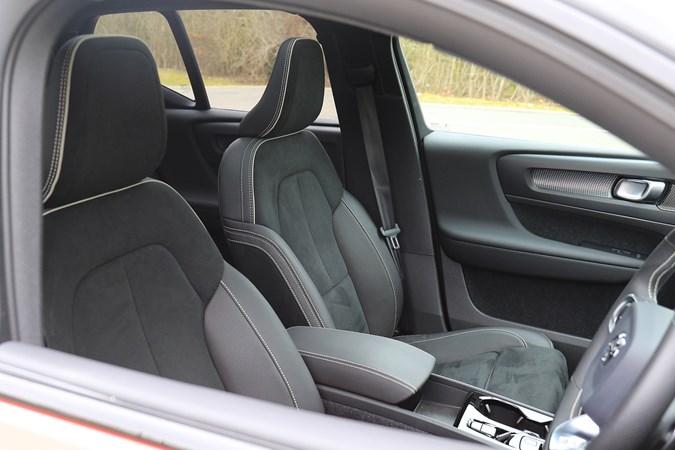
The same could be said for the suspension, which is surprisingly soft despite the big wheels, and doesn’t thump over obstacles or patches of broken tarmac. It’s not limo-like, square edged potholes and large speedbumps can catch it out, but generally it strikes a nice balance between body control and comfort. It’s particularly good on the motorway, too.
Obviously the silent cabin contributes heavily to the overall sense of peace and refinement, which is fine until the battery runs out. The three-cylinder petrol engine is no louder than rival units (and actually I think it sounds quite good) but you’ll notice a bit of vibration at tickover and a gruff note on the move.
The best thing really is to keep it charged up and always put your destination in the sat nav before you leave, so the car can stretch out the battery life over the whole journey (but again, more on this later).
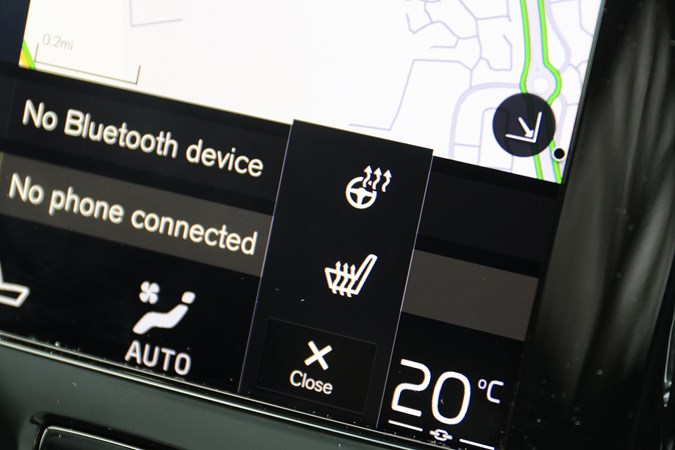
By far the greatest asset towards comfort is – like with most PHEVs and EVs – the fact you can set the climate control to come on before you get in while you’re still in bed. This is controlled via the Volvo app, which is very clear and easy to use, and the car draws power from your house to warm up the cabin, heated seats and wheel, plus it can defrost the windows if it’s icy.
I’ve been making good use of this over the winter, particularly the timer setting, which means the car’s automatically warm in time for the school run without me having to do anything. The only problem is my kids taking ages to get into their seats, prompting me to say ‘close the door, you’re letting all the heat out’.
Volvo’s image might have got dramatically cooler during the past ten years but this XC40 has still managed to turn me into my Dad. Maybe now’s a good time for an impulsive motorbike purchase to even things out.
Update 3: Performance and handling
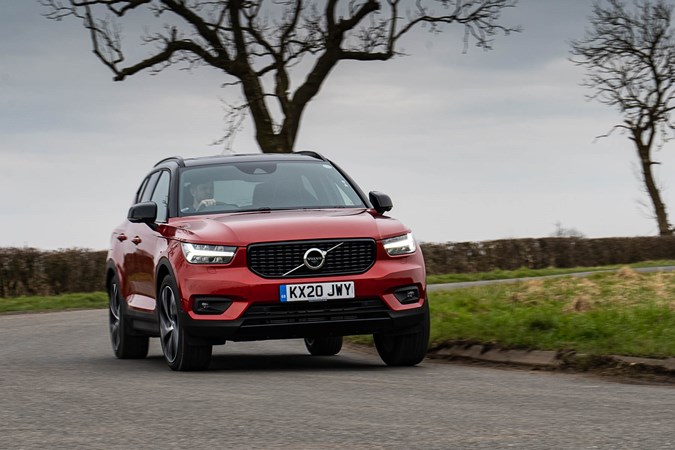
The plug-in hybrid XC40 uses a petrol engine and small electric motor in combination. Is it the best, or worst of both worlds, given cheaper petrols and a longer range EV exist within this car’s line-up?
Choosing an engine for your Volvo XC40 is relatively easy – there are pure petrol models at one end, and electric version at the other, and various combinations of the two in the middle.
We’ve got the best-of-both-worlds PHEV version with a T5 badge (which is cool if you’re a car nerd but a bit meaningless to everyone else) which means a very useful 0-62mph time of 7.3 seconds. Volvo reckons you’ll get 27 pure electric miles if you don’t use the petrol engine at all and 134mpg and 48g/km of CO2 if you do.
Two things about this version are interesting – the fact it makes 262hp, and that it comes with a seven-speed automatic gearbox rather than an eight like most other Volvos. But more on both of those later.
What other engines are available?
The base petrols are called T2 and T3 and both are a bit slow but (in theory) cheap to buy and run. Next up is the B4 and B5 (these ones are mild-hybrids) which will appeal more to enthusiastic drivers, particularly the latter, which can crack 0-62mph in 6.4 seconds.
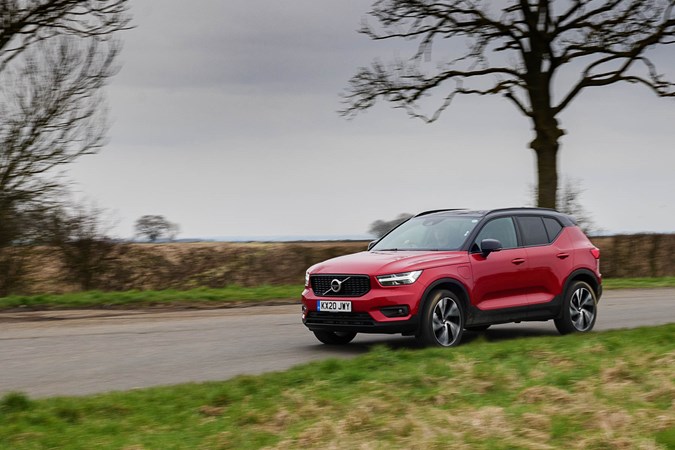
Volvo offers two plug-in XC40s, the Recharge T4 and T5, and these make use of the 1.5-litre, three-cylinder petrol found elsewhere in the range, boosted by an 80hp electric motor. Both are front-wheel drive only, as I found out by nearly getting it stuck in a muddy bike park car park.
Finally, the pure electric XC40 packs 402hp and 600Nm of torque and is fast – as in, 0-62mph in under five seconds fast. But that’s enough about that car, I’ve got another update planned where I compare the two and don’t want to spoil it.
What’s the Volvo XC40 Recharge T5 like?
Very good – but it’s worth pointing out that my lifestyle has changed a bit over the past year (as, I suspect, has everyone else’s) which has undoubtedly endeared me to this car more than under normal running conditions. As I shall now explain.
For a start my regular drive to the office has been replaced by a school or shopping run, meaning I didn’t visit a petrol station for several months at the start of 2021, because its battery range was more than enough for the short journeys I was doing. Left to trickle charge on a three-pin plug in my garage, it was always full too.
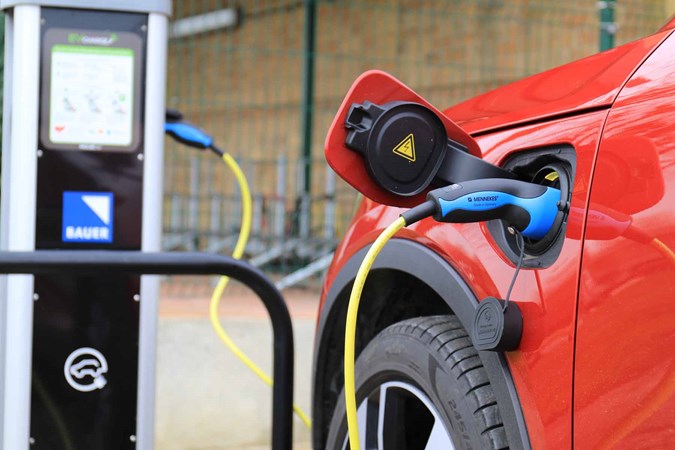
With my commute gone so was my regular source of solo miles – because of Covid, if I was going out in the car, it was usually to do some sort of task and that meant my family tagging along. I don’t know about you, but I drive quite differently with passengers in the car, and the XC40 fits this relaxed style really well.
The best PHEVs I’ve driven have been like this one – it’s not slow by any means (as we’ll get to), but it’s just so much nicer to drive slowly, that it feels more rewarding kept at as gentle a pace as possible. This subconsciously encourages a lighter right foot and therefore better fuel economy.
A gauge where the rev counter should be in the dial screen shows you how much of the electric motor’s reserves you’re using and at what point it’ll require a switch over to petrol. This helps you keep it in EV mode for as long as possible, not that the combustion engine is noisy, but it’s just more pleasant wafting around with electric power.
On 30 or even 40mph roads this is easy but getting up to 60mph on battery alone takes a while, and I’ve found it better to accelerate on a bit of petrol power and then coast on the battery. The B mode (brake regen) is also very handy if you’re able to plan far enough ahead – it’s not as fierce as a one-pedal type system but allows you to decelerate steadily and avoid wasting energy by standing on the brakes.
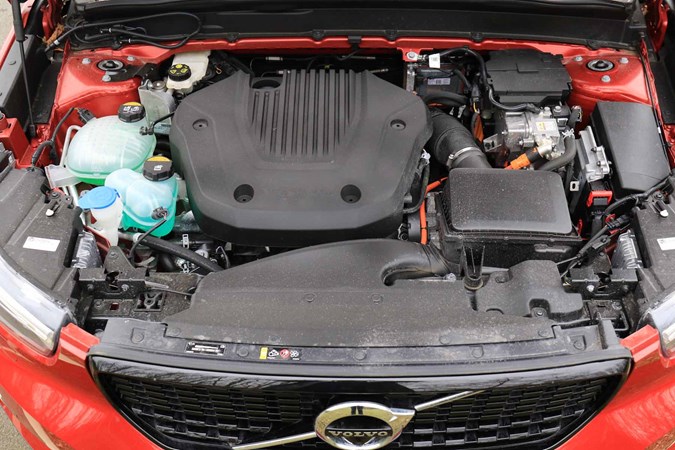
As with all fuel-sipping cars though it’d be much easier to drive them efficiently if you were the only person on the road. Drivers of conventional petrol and diesel cars often won’t tolerate a slow run up to or down from 60mph, and several times have overtaken me while I’ve been regenning my way to a roundabout, only to slam their brakes on seconds after. As such, you have to drive in a sort of compromise between rally Harry and eco-conscious.
In fairness, I’m usually the former, so it’s a bit hypocritical for me to complain.
What about when you want to get a move on?
The first proper test of the XC40’s dynamic ability came later in the year when we were allowed to arrange photoshoots of our long termers, and I was really surprised at how much fun the XC40 could be when you turn the heat up a little given everything I’ve just said about how good it is at a more relaxed gait.
Having never had a need to alter the drive selector, I discovered that switching up to Power Mode brought new-found levels of responsiveness and thrust I had long since assumed were not part of this Volvo’s talents. It was a bit like going for a jog with a friend and discovering they could run a four-minute mile.
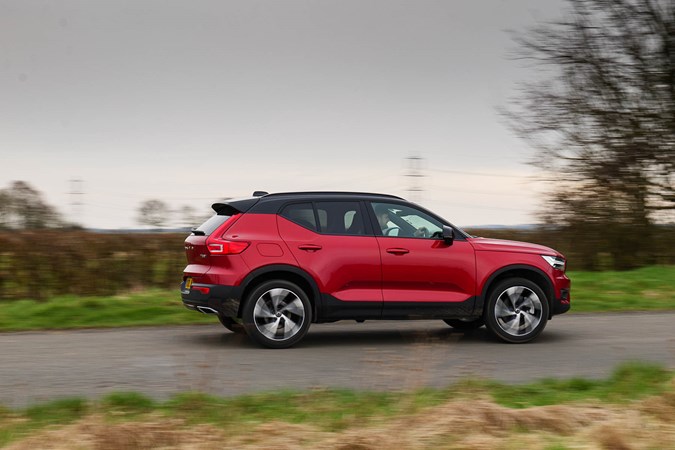
It’s really punchy in Power mode – I’d long since assumed the 262hp was a bit numbed by the weight and boxy aero of the XC40 – PHEVs often have quite powerful engines that don’t quite deliver in the way you’d expect them to in a conventional car.
However, with the petrol and electric motor working in tandem to prioritise performance rather than economy, it’s really quick and even sounds quite cool. Best of all really is the dual-clutch automatic gearbox – a much more modern solution than the eight-speed conventional auto we’ve had in previous Volvo long termers, offering faster shifts when left to its own devices and much better responses to a click of the wheel mounted paddles.
What about the handling though?
For the most part it’s classic Volvo – very safe and controlled but not the last word in involvement. The wheel’s numb to what’s going on under you and there’s a bit of bodyroll but not so much that you feel like it’s lurching from corner to corner.
Grip levels are high even in this front-wheel driven model though and that means it’s possible to hustle it down a B-road at quite a convincing pace, it’s just you’d be enjoying yourself more in something like a Mazda CX-5 or SEAT Ateca.
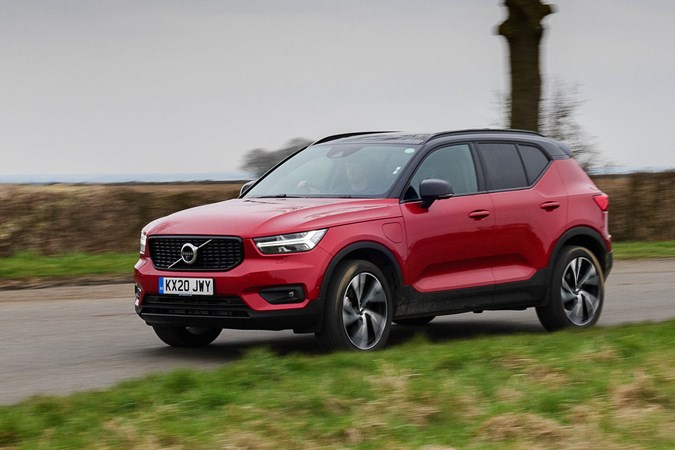
The biggest problem in this specific model really is the brake pedal, which (like all PHEVs) is a bit vague-feeling at the top of its travel and then suddenly clamps on the anchors without much sensation through the sole of your foot. You do get used to it, but I definitely spend the first ten miles or so of a journey making my passengers look like the characters from Wayne’s World headbanging to Queen if I’ve not driven it in a while.
Sounds kind of annoying…
I’m being super critical here – overall the XC40 is a wonderful surprise in many ways. I was expecting the R Design suspension to be teeth-shakingly firm, and it’s really not. At the other end of the spectrum, I though the handling on a faster road would be all boring understeer with the traction control light flashing like a faulty streetlamp but it’s actually a bit of a revelation.
The dual-clutch automatic gearbox is the biggest component of this, because it makes the whole car feel more alive and responsive. When you’re driving normally though it’s super smooth and shifts sometimes without you realising it.
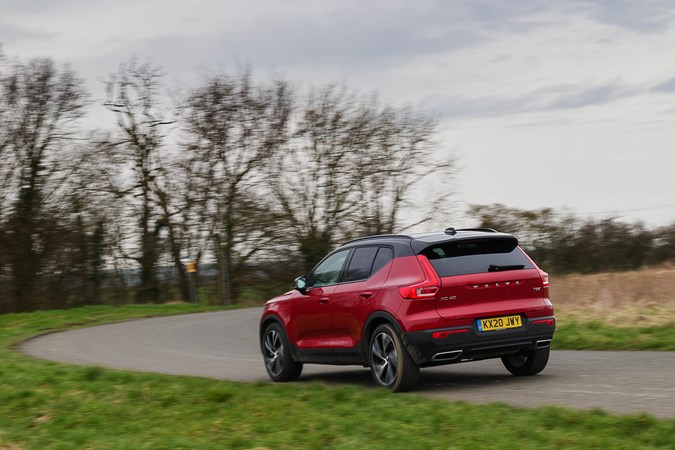
So it’s a great Jekyll and Hyde car then. Either easy to drive and relaxing or rapid depending on your mood. The best thing is, it’s the first car I’ve driven for a while where I feel like I don’t regularly use its performance potential, not because I don’t have the opportunity but because I don’t feel the need to. It’s not going to waste, it’s just there when I need it.
A quick word on economy too – I’m currently getting 45mpg, but we’ll go more into that in the verdict update.
Update 4: Volvo XC40 T5 PHEV vs pure electric P8
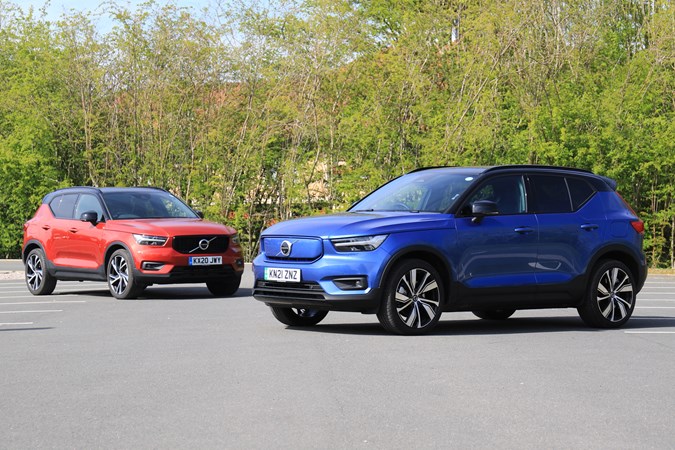
This is it – el queso grande, the big test, is the plug-in hybrid XC40 with its petrol engine and batteries worth it or are you better off just getting the electric model?
There’s a weird thing that you will have to get used to if you have a car on your driveway with a power cable coming out of it – people you don’t know will ask you how far it’ll go, and then look disappointed.
This has happened half a dozen times so far, with everyone from mail carriers, takeaway drivers, and even the man who came to fix my neighbour’s fence being confused by the XC40’s 25-mile-ish electric range.
Weirder still, I feel the need to defend it, explaining that it’s only the plug-in hybrid model and that it has a petrol engine if I want to go further than that, but actually, I rarely do. Then I shut the door and wonder why any of that is anyone else’s business.
However – as you might recall I mentioned before about not gelling with my last PHEV long termer because all of my journeys were longer than its battery range, and so it was basically using petrol all the time. Albeit less than a pure combustion model, but still more than a diesel.
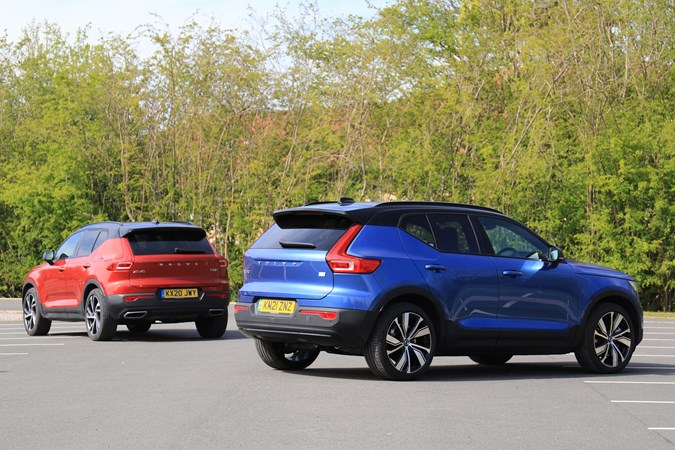
This time around though, because my lifestyle has been flipped on its head by Covid-19 (as I suspect it has for many) the majority of my journeys are powered by smooth and silent electricity. And I really like it. As a method of transporting your family around, an EV makes a huge amount of sense – quiet, serene, and free from jerky gearchanges – it’s a really relaxing method of propulsion.
In the time between my VW Golf GTE and now, electric cars have come on a serious way too. No longer a compromise for those prioritising zero tailpipe emissions alone, now the electric model in some manufacturer ranges is the most attractive for many reasons.
Take the Volvo XC40 Recharge P8 for example – not only is it the fastest and most practical configuration, but if you’re a company car driver, by far the cheapest to run. It’s also got Volvo’s fancy new Google-powered infotainment system, which the combustion car will have to wait for.
I said at the beginning of this test I’d be getting both cars together to see whether the PHEV is a kind of worst-of-both-worlds middle ground, being more expensive than a regular petrol with none of the benefits of the pure electric, and now I’ve got both cars on my driveway to work out which is best.
What’s the P8 like to drive?
Really good, in that all-grip-and-straight-line-speed way that most electric cars are. It’s fast – hot hatch fast, with a 4.7 second 0-62mph time that puts the T5’s seven seconds to shame – and a big, torquey response to the throttle pedal.
| Model | Power | Torque | 0-62mph | Electric range | CO2 | Fuel economy |
| P8 | 408hp | 660Nm | 4.7 secs | 256 miles | 0g/km | 2.5-2.6kWh per mile |
| T5 | 262hp | 425Nm | 7 secs | 27.3 miles | 49g/km | 128mpg |
The T5 isn’t exactly slow, to be fair, but because it has a gearbox and two methods of propulsion to manage at any given time, it’s never going to feel as reactive as the pure electric car. But the P8 is not a one trick pony – a long and progressive pedal means you can waft around making smooth progress or bury it to get both motors working hard.
With that power though comes great kerbweight – over two tonnes in the P8, which affects the handling less than you’d have though because it’s all pretty low down to the ground. In short, both it and the T5 have the same safe and grippy but not hugely fun feel, which is typically Volvo and absolutely not a complaint.
Isn’t the electric version really expensive though?
It is the priciest version in the range and if you compare the high spec P8 we drove to our R Design T5 there is a gap of more than £10,000, but there are cheaper versions available and a less powerful model on the way, which will likely be even more competitive.
Where the P8 really comes into its own though is as a company car, because like all EVs it has a 1% BIK rate and therefore costs peanuts in monthly tax.
Of course the running costs will vary depending on your electricity supply arrangements, but Volvo quotes 2.5-2.6kWh per mile and 248-260 miles of range. A 150kW charger will take you from flat to 80% in 40 minutes, too.

At the time of writing the P8 wasn’t available on PCP finance like the T5 (a robust £389 a month) with Care by Volvo your only rental option, coming in at £719 a month.
Surely all those batteries means it’s less practical?
Not so – the XC40 is built on a platform that has always been earmarked for electrification, which means the P8 actually has more luggage space.
That’s because while the boot is eight-litres smaller (452 vs 460 litres in the T5) there’s another 31-litres under the bonnet where the engine should go.
In reality this is likely to become cable storage, but that in turn means less stuff rolling around in your boot, resulting in better load carrying capability.
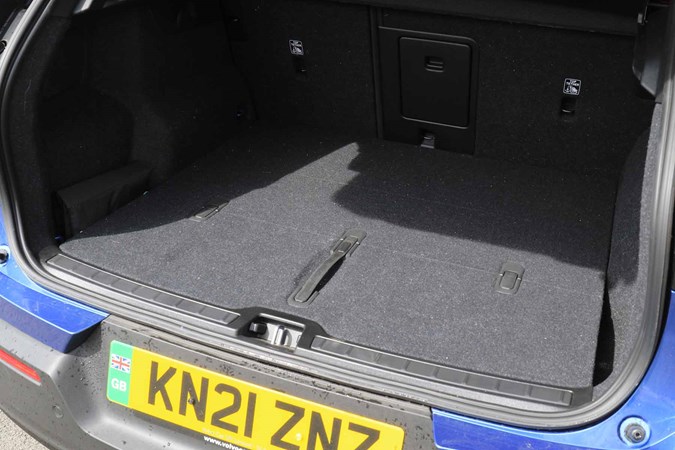
If it feels like I’m rushing a bit here it’s because we’ll talk more about practicality in the next update, and for all intents and purposes, it’s exactly the same whether you choose T5 or P8.
Verdict
It might sound like damning it with faint praise but budget allowing there is no reason why you shouldn’t pick the XC40 P8 over the T5.
That’s actually a big deal when it comes to electric cars, which until this point have felt like a compromise in terms of practicality and range in order to attain a cleaner footprint.
In actual fact, the electric XC40 feels like the best car in the line-up – it’s the fastest and nicest to drive, and if you’re a company car driver it’s a no brainer – if your firm will stomach the lease cost, of course.
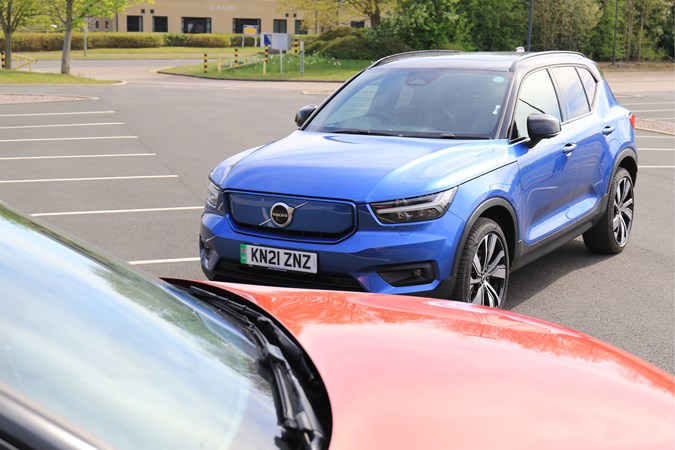
I really like the T5 PHEV, because it has the flexibility to offer short zero-tailpipe emission drives or longer petrol-powered ones with no stress and worry about having to find a charger, and I can definitely see how this would appeal.
But for me, I’d pick the EV again and again. If only to stop strangers on my driveway turning their nose up at its range.
Update five: Practicality
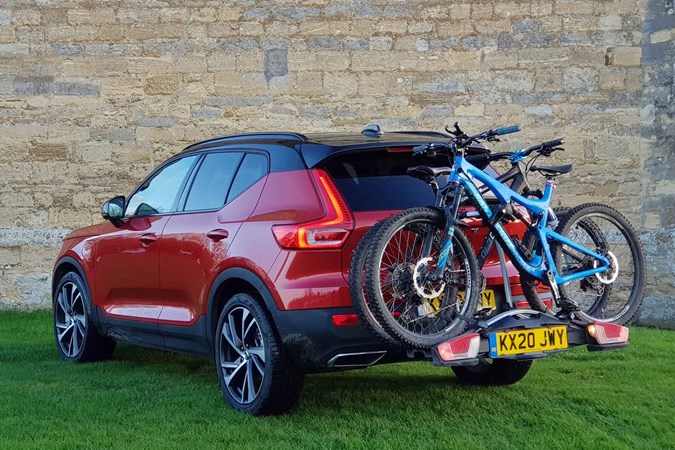
Is a family of four and their associated paraphernalia, plus PHEV batteries and electrical gubbins, too much for the XC40 compact SUV to carry?
Volvos and practicality used to go together like meatballs and chips, but as I’ve highlighted in previous long-term reports, the Swedish maker has shifted its focus recently from making big and boxy spare rooms on wheels, to more svelte and stylish offerings like this XC40.
I’ll be honest, I was initially a bit concerned about how my young family would fit in a small SUV, especially as it’s a plug-in hybrid – a drivetrain that usually requires losing litres in the boot in order to fit electrical batteries and wires.
This is a result of the PHEV tech being shoehorned into a chassis that wasn’t really designed to take it, but the XC40 was build on a new platform with electrification in mind. That means space for batteries has been left down the centre line of the car, so you can’t have an all-wheel drive model, but on the flipside petrol, PHEV and EV models all offer the same bootspace.

Volvo provides two volume measurements, either 452 litres up to the window line, or 578 litres crammed to the rafters. This is quite handy because realistically you don’t want to routinely block out the entire rear view, and 452 litres is a genuinely useful amount of space.
Drop the rear seats and this increases to a total loadspace of 1,328 litres, which is good enough for a substantial tip run or a massive mountain bike (minus the front wheel of course).
What’s more the boot itself is a big square with no intrusion from the wheel arches – and the narrowest point is exactly the same width as an Ikea flatpack box. I refuse to believe this is some sort of Swedish coincidence.
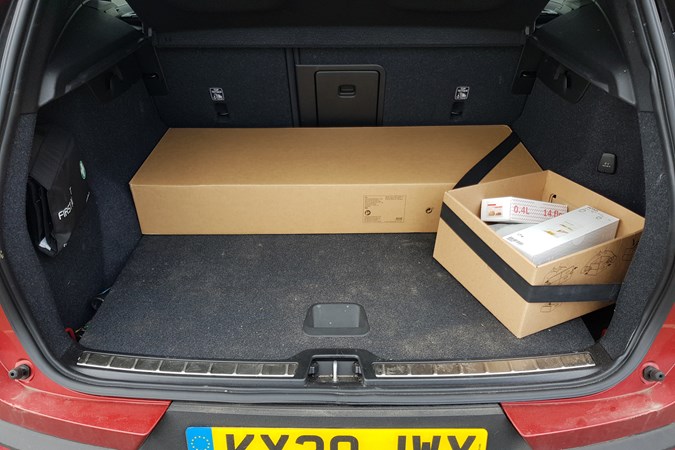
We like riding bikes in our family (as you’ve probably noticed) and the XC40’s pop-out tow bar has been an essential upgrade to the car. You press a button in the boot and it appear from nowhere, although you have to complete the second stage of the process manually, but this isn’t unusual.
Once hooked up to the electrics the lights on my Thule rack work perfectly and because the XC40 isn’t an enormous car (unlike my previous Audi A6 Allroad) it’s not particularly stressful to park, even with the additional length attached to the back.
What’s more, the tall boot easily fits a balance bike and 20-inch mountain bike (again, minus the front wheel) and with a clever bit of bungee cord routing, the latter is held securely in place too.
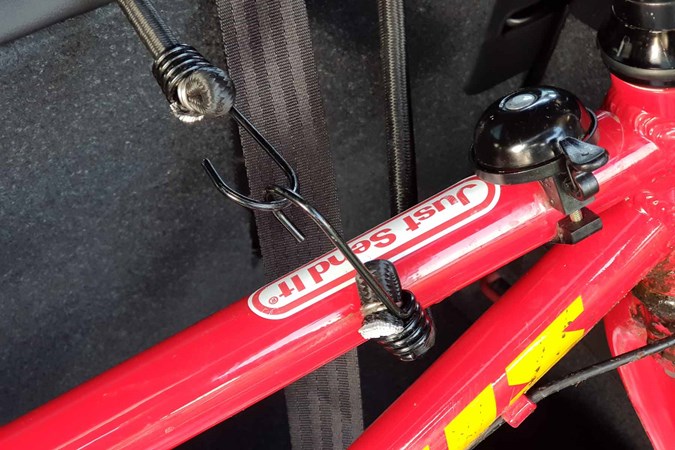
On the subject of kids, our chunky Isofix fits easily thanks to plastic tunnels in the seat backs to help locate the anchor point.
That said, the rear doors don’t open particularly wide so it was often a slightly tense installation, particularly with a large and vulnerable metal wheelarch panel just waiting to be scratched by the seat’s sharp legs.
When upright my three-year-old found the back of my seat within easy kicking distance, but bear in mind this isn’t a huge car, and my driving position is quite a long way back.
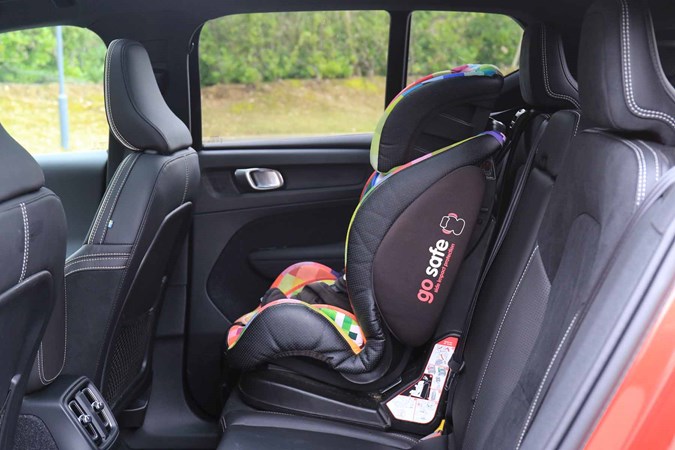
Somewhat at odds with that conclusion is the fact that adults have loads of room in the back, even with our optional glass panoramic roof, which normally eats into the available headspace.
I had loads of knee room and space for my feet, without having to slouch or duck down to make enough room for my head, even on a tall hair day.
Up front things are a bit stingy in terms of storage space – the underarm cubby isn’t very deep and while you get two cupholders, the space in front is taken up by the wireless charger. Although that is a very useful addition.
The glovebox is a bit tight too but one thing that is worthy of note is how huge the door bins are. Can you see what’s missing from the picture below? That’s right, there are no speakers in the door taking up space you could otherwise use for bottles or umbrellas.
The XC40 uses a clever stereo design that moves the bass speakers behind the dashboard. It still sounds great too, so there’s little compromise there.
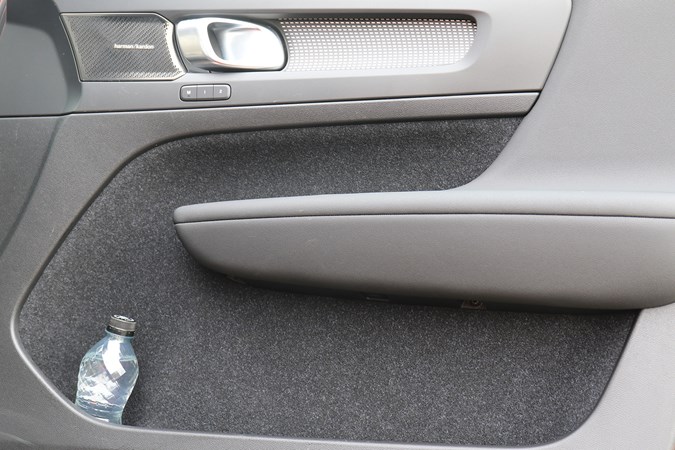
All-in-all the XC40 is a really clever bit of packaging – it looks compact from the outside but has loads of room for passengers and luggage on the inside.
More than you’d think it would have, but not more than you need. But then every long termer I’ve run since the Skoda Octavia vRS Estate has had that car’s vast 610-litres of space to compete with. So it’s not really a fair fight.
Take your own needs into consideration but my family of four has managed with the space on offer so far – but if I owned this car I’d certainly be looking at roof boxes to help carry the things we need on a longer trip away from home.
Update Six: Farewell
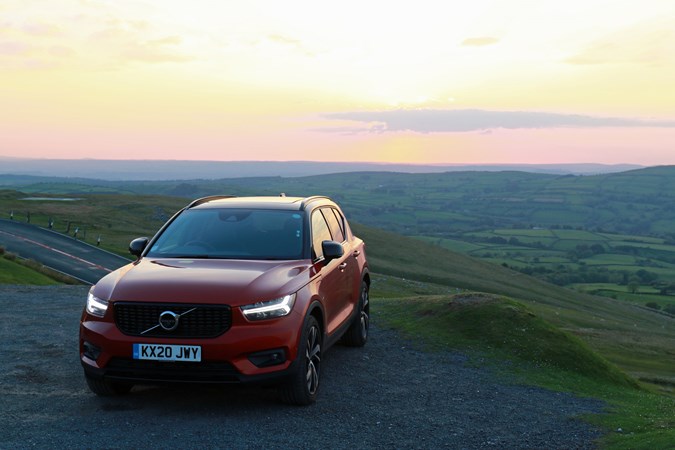
It’s time for the XC40 to go and I am bereft, because it’s been utterly brilliant family transport. Err sorry, spoiler alert
After 8,000 miles it’s time to return the Volvo XC40 long termer, and it’s going to leave a big hole in my heart – my initial concerns about it not being big enough or the PHEV drivetrain being more of a hindrance than a benefit have been proved wrong, and it’s become a proper family member in the way all good cars seem to do.
Let’s get that first concern out of the way. As I alluded to in the welcome update, the 25-ish mile electric range is now suitable for my current lifestyle as reshaped by Covid-19, in a way the last PHEV I ran was not.
With no long daily commute and fewer opportunities to disappear off to a bike park in Wales or Wiltshire it spent a large part of the first few months without lifting a piston. And as propulsion method for a family containing two young children, I can’t speak highly enough of electric power.
Smooth, quiet and with seamless acceleration it’s just about perfect for relaxing trips, and even as travel restrictions relaxed, the range seemed long enough for our weekend journeys. And with driving for the sake of it reduced to a minimum, the XC40 was able to maintain a full battery whenever I needed it with nothing more than a three-pin charge.
In terms of performance the XC40 was adequate – its headline horsepower figure makes it sound like a hot hatch but bear in mind the extra weight of the PHEV system and the fact it’s usually configured for maximum efficiency and the result is straight line speed that feels rarely wanting nor exciting – it’s just right and nothing more. Flip the drive mode into Power and things get a bit more responsive, but not enough to shock and awe, and backed with a soundtrack that was certainly willing but unstirring from the 1.5-litre, three-cylinder motor.
Despite the drivetrain, practicality didn’t take anywhere near as big a hit as I was expecting – this small SUV is built on an electric-specific platform so the PHEV and EV have just as much boot space as the standard petrol cars. Actually the EV has a little bit more. I came to really admire the XC40’s clever packaging because it meant we had plenty of space for our bulky hobbies but didn’t have to wince when navigating a narrow street with high kerbs, because the car has manageable external dimensions.

I also didn’t wince nearly as much as I thought I would when traversing potholes or the noisy bits of the M25, because despite sporty R Design suspension and 20-inch wheels, the XC40 rode nicely too. There were times when it felt a bit overwhelmed by a sharp-edged road defect, but this was very much in the minority.
Inside while Volvo did a good job of bringing the quality you get in its larger cars into the cabin of the XC40, there were a few more areas of hard plastic (resulting in an annoying squeak where the centre console and transmission tunnel met), although over time it wore well, and resisted that tired look car interiors rapidly develop when faced with young occupants grinding biscuits into speaker grilles or rubbing shoe soles with embedded stones into the seat backs. So maybe the choice of plastics was a wise one.
Really though, and without wishing to sound superficial, it was the way the car looked I came to like the most. It’s a handsome thing, and that’s coming from a committed wagon-enthusiast in the ‘estates vs SUVs’ debate. Other people seemed to like it too – I once spotted someone doing a full, owl-like 270-degree double take as they walked past it in a car park, before getting into an almost identically specced XC40, minus the contrast black roof.
It manages to look substantial and stylish without being flashy, yet chunky and capable without crossing over into agriculture. A really nicely judged design that will age well, while driving forward the Swedish maker’s future family face.
But I’ve waffled on without answering the initial question in this test, so let’s address that now. I’ve enjoyed the electric part of this PHEV so much I’d now be swung by the pure electric XC40 Recharge P8. Which means the T5 has shot itself in the foot a bit.

In fairness, it worked brilliantly for me during the limited mileage months of Covid-19 lockdown, but now we’re able to travel further to see much-missed relatives or work from the office, the sub-30-mile electric range can’t really keep up.
So once again my conclusion has to be one of those ‘pick the right drivetrain for you’ cop outs. For some the T5 will be ideal, others will want the P8.
I will leave you with this thought though – plug-ins may have been the best of both worlds when electric cars were limited to quirky hatchbacks with small batteries but that’s rapidly becoming something from the past. And while the T5 is a brilliant car, the P8 is just that little bit better. Such is the rate of progress.



